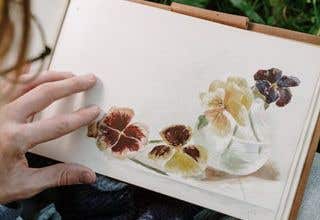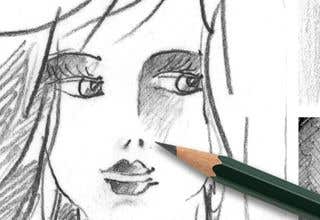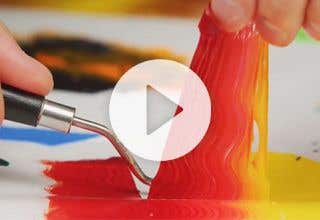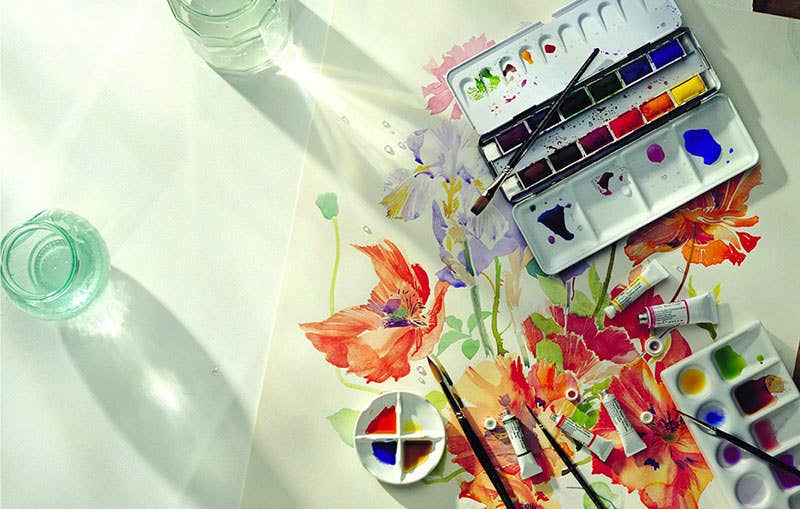
Watercolours are like no other painting medium. Defined by vibrant yet subtle colours with clean and clear transparencies, the layers of thin washes created by this delicate mix of paints results in luminous effects that appear to glow on paper.
The attractiveness and distinctiveness lies within the paint’s properties; made from either natural pigments found in the earth – minerals, clay etc – or from synthetic pigments that have been finely ground down and bound with a water-soluble based “gum”, watercolours settle on the surface of your paper once the water has evaporated. Not only can you mix colours easily and well, you can lift pigment off the surface to reveal the white of paper underneath.
If you’re deciding on a new painting medium, watercolour is one you should look at. Easy to clean up, free from harsh chemicals, relatively inexpensive, transparent and reusable, there are plenty of benefits to painting with watercolours. But as with any painting medium there are a few mistakes you should be sure to avoid. Here are a few common watercolour mistakes that anyone new to the art should be wary of.
1. Muddy colours
One of the most common issues watercolour painters face when starting out is a mistake known as “making mud”. When you attempt to paint on top of a damp layer, muddy colours occur. This can leave you frustrated and unwilling to continue. As a rule, you should only ever apply watercolours to either completely dry or very wet paper. Damp will lead to all sorts of trouble.
To avoid “making mud”, add paint when paper is bone dry or shiny wet only. If your paper is a dull matte, it does not want more paint loaded on. Consider using a glazing technique (which almost guarantees no mud) and paint with staining paints, i.e. Prussian Blue and Pthalo Blue. Mixing two or more opaque paints can also lead to muddiness, so if you’re finding this an issue and you’re following the water rule, try to exclude opaque paints and minimise the number of colour variations mixed.
2. Unwanted back-runs
When you go back into a damp wash with a watery brush it can lead to unwanted back runs. The painting below shows what happens. What is supposed to form shadow ends up as a pale back-run.
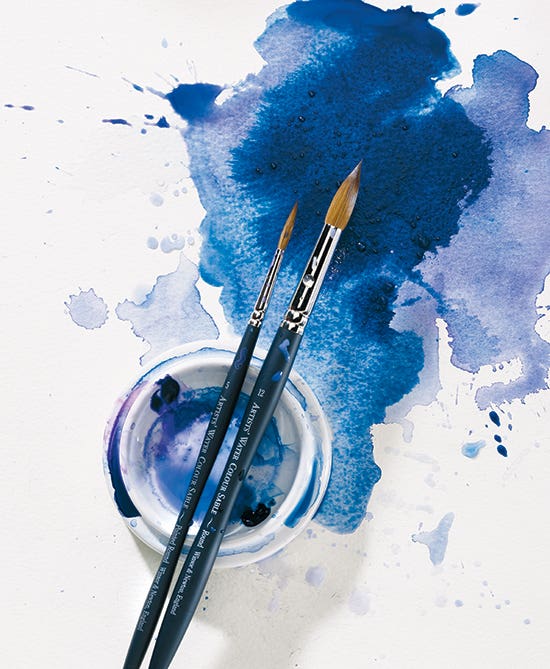
It’s not that you can’t add colour to a wet wash, it’s just that your brush must be wet enough and loaded with pigment. Apply a lot of pigment on a dryer brush and you should have no trouble creating a form shadow such as that needed above.
3. Loss of luminosity
When you find yourself overworking your painting to add more and more details and touchups, your painting will lose its brightness and luminosity. All it takes is one wrong brushstroke to cause a panic and overload of colour.
It’s important to remember when using watercolours that it’s better for a painting to be underdeveloped than overworked. Overworking will dull your painting and chase away your reason for using watercolours in the first place. Try not to focus too much on the details by fussing and correcting. The fewer the layers, the fresher the painting. Also, avoid softening a dried edge.
4. Unnatural Objects
When painting natural objects, it’s important not to outline. Often, beginners outline objects with a dark colour when painting a background, but this can be a big mistake. What happens is the natural object then becomes “unnatural”, as if cut out and stuck to the background. When painting petals for example, vary the colour and value around each petal instead of painting with a hard edge. Alternate the direction of your brush strokes and blend your hard and soft edges. The mix of contrasting values, colours and edges will bring focus and depth to your natural objects.
5. Wrong sized brush
Another very common watercolour mistake, particularly for beginners, is using the wrong sized brush. Often you’ll be tempted to use a small brush as it makes you feel like you have more control over the stroke size and level of detail. However, using a small brush will require more strokes to cover a larger area, making your watercolour look rough. On the other hand, using too big a brush can also cause you problems. A big brush will have higher water content than a small brush, and so using one may wash away other layers of watercolour on your painting.
Make sure to use a brush size that’s appropriate for what you’re trying to achieve with your watercolour painting. For example, only use a small brush for detailed work, and use a big brush when covering a large area like the background of your painting. As a general rule, you should only need to use a small brush for finishing touches at the very end of painting.
6. Bleeding
If two or more colours are too close to each other when wet, it will cause the paint to bleed. This is not always a bad thing. Wet in wet is a technique every watercolour painter should trial, as it results in beautiful, blurry blends of paint perfect for moody foregrounds or backgrounds.
But let’s just say you’re not painting a background or foreground and you want to keep colours separate. It’s important you work on completely dry paper. If you do get a bleed, dip your paintbrush in water and gently paint over the bleed area to soften. Let it dry and paint over the area again with the appropriate colour to fix.
7. Rushing
Because overworking watercolour is not a good idea, watercolour is a fast medium. The longer you work on it, the more layers you add to it and the duller your painting appears. That said, you should never rush a watercolour painting. Good solid drawing and planning is required.
Nothing is worse for your watercolour painting than a bad start. Start right and every step will be so much simpler. This doesn’t mean scrutinise the detail, but it does mean taking your time with your drawing before working fast on washes. If your painting requires drying time, be patient and let it dry.
See where your watercolours can take you
As far as paint mediums go, watercolours get a bad wrap. Labelled as “unforgiving” and “unpredictable”, artists often fear them, but avoid the mistakes above and watercolours are a pleasure to work with. If you do make a mistake with watercolours it can be difficult to correct, but not impossible. If you go with the flow you might be surprised by just how beautiful a mistake can be. Often “happy accidents” result in the most breathtaking works, so instead of starting again, keep going and see where your watercolours take you. If you’re thinking of painting with watercolours, Eckersley’s have a vast range of watercolour paints and brushes to fulfill your needs.












